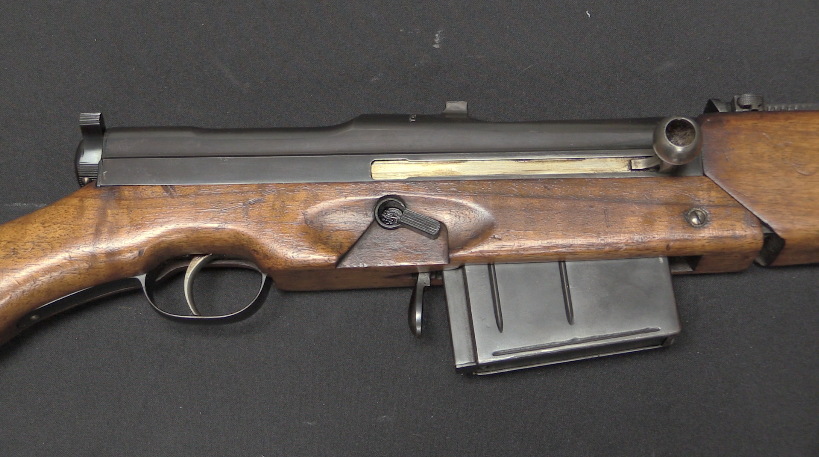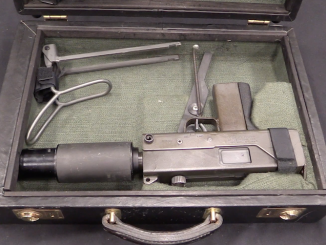The Czech ZK-383 is a magnificent submachine gun, but sadly very scarce in the United States. So when I saw the semiauto example, I wanted to take it out to the range for some plinking. It has some magazine issues (as one might expect form a one-off semiauto made by a hobbyist here in the US), but is an interesting option for someone who can’t find a live and intact example of a ZK-383…
Related Articles

Prototype
RIA: CZ Model S Prototype (1929)

Accessories
MAC Operational Briefcase

Light MGs

Good shooting show!
Wiki says: designed in 1930, manufactured during years 1938-48 https://en.wikipedia.org/wiki/ZK-383
That means it could not reach into War of Chaco in which los Checos were on side of Bolivia. That does not seem to make sense, because I recall reading it was used there. https://en.wikipedia.org/wiki/Chaco_War
Your comment correct, different photos in the following three examples show it quite plainly in the hands of Bolivian Forces during the Chaco War :
SAPIENZA Antonio. The Chaco War 1932-1935. Fighting in the Green Hell. Latin America @ War No 20. Helion Publications, Solihull, 2020.
de QUESADA Alejandro. The Chaco War 1932-35 : South America’s greatest modern conflict. Osprey Men at Arms No 474, London, 2011.
HAGEDORN Da & SAPIENZA Antonio L. Aircraft of the Chaco War 1928-1935. Schieffer Military History, Atglen, Pennsylvania, 1997.
Thanks for your response, Gordon!
I am sorry to disagree, but I checked the Osprey title on the Chaco War by Alejandro de Quesada and Phil Jowett Osprey you mention and there is not a single photograph in it showing the ZK-383 in Bolivian army use. What can be seen are ubiquitous Mauser rifles, Madsen LMGs and even a 20 mm Semag cannon, captured by the Paraguayans from the enemy. And water-cooled Vickers and Maxim guns too.
Regarding SMGs, the authors say (p. 24) that “Bolivia had purchased quantities of several models available in the early 1930s, including the Bergmann MP28, the Steyr Solothurn S1-100 and the Vollmer VMP30, all in 9mm caliber. (the Bergmann and Steyr looked very similar, and because of this other Bergmann and Erma models are sometimes quoted as being in service with the Bolivians.) In addition, some Finish sources say that small numbers of the Suomi M31 found their way to the Chaco War.
Some sources also state that the Paraguayans had some US Thompson M1928 SMGs, but there is no photographic evidence of this, and it is doubtful if they bought any SMGs of their own to supplement their ex-Bolivian captures.”
I got the Hagedorn and Sapienza book on the aircaft of the Chaco War when it was released, but unfortunately I have it in another house so I can’t check it atm, but I don’t remember it containing many pictures of ground troops.
If you are interesting about Bolivia vs Czech weapons, I think
http://www.vhu.cz/exhibit/ceskoslovensky-vyvojovy-samopal-zk-383-p/
this will be better reading, though it does not deal with ZK 383 sz. but ZK 383-P which is NOT sub-machine gun but automatické zbraně s malým balistickým výkonem (I do not know English-language term for that).
Thanks Daweo, I appreciate your input – as always!
“Wiki says: designed in 1930(…)”
Well, it cites modern firearms which actually says https://modernfirearms.net/en/submachine-guns/czech-republic-submachine-guns/zk-383-eng/
The ZK-383 submachine gun was developed during late 1930s by Czechoslovak arms designers brothers Koucky
(bold by me)
How they were able to lost that information during translation from English to English is beyond my comprehension.
“(…)1938(…)”
If I understand correctly enough http://www.vhu.cz/samopal-zk-383/ states that it was adopted kulometná pistole vz. 38 in September 1938. there is also drawing available which dubs this weapon KULOM. PISTOLE ZK 383 sz. so second is apparently alias for first. Interestingly this weapon was initially developed for čs. náboj vz. 22 which was certain loading of 9×17 Kurz cartridge and default automatic pistol cartridge inside Československá armáda https://naboje.org/node/3680
First mention of ZK 383 with changeable barrel is from February 1939 and is contemporary with mention of “100-round magazine for German cartridge” (i.e. 9×19 mm Parabellum). By March 1939 they have ready assembly drawings(? I am not sure here ?), month latter patterns(?) for Bolivian customer. There existed 2 examples made in .45 Auto cartridge for Argentine. This weapon in form as we know today in early 1940 (perforated barrel jacket, bi-pod, Rate-of-Fire lowering device &c) and was named ZK 383 sz to denote box magazine. First huge customer were Bulgarian forces, which contracted production of 4000 examples, they were delivered in 3 batches (500+1400+2100) with last being received 30 December 1942. Bulgarians ordered further 1600 examples, but that was not realized. Slovak forces were are also interesting in obtaining 20000 examples, but finally consumed only 190 examples and changed mind “we will buy German pattern sub-machine guns only”. In 1942 there was order from Croatian Defense Ministry for 400 examples, due to lack of raw materials none were actually delivered.
ZK 383 was first mass-made Czechoslovak sub-machine gun and is only sub-machine gun made by Zbrojovka Brno in significant numbers. After war 2695 examples were left in factory, Czechoslovak Ministry of Defense was not interested in them so they allowed to export. These leftovers went to Venezuela (1200 examples in 1947…1950) and Bolivia (1000 examples in 1948…1951).
I am unable to comprehend from text who is at 5th image from left, does someone know that?
ZK 383 was first mass-made Czechoslovak sub-machine gun and is only sub-machine gun made by Zbrojovka Brno in significant numbers.
—————–
That appears to be true, since the samopal vz.23/25 and following series were developed and made in Ceska Zbrojovka Strakonice.
The ZK383 was btw. also implemented in border fortifications during September 1938 crisis.
“(…)samopal vz.23(…)”
If using year system, then it is Vz. 48a
https://modernfirearms.net/en/submachine-guns/czech-republic-submachine-guns/sa-23-eng/
above name would imply 1923, thus making it earlier than ZK 383. Why there is such wide support for naming hoax of Vz. 48a ?
Reduced mass of moving parts are too heavy.
Perhaps the hammer works like a API.
Rather, the front of the bolt is relatively light, and the mass of the second is comparable to the first.
Apparently, when fired, the first part is already starting to roll back, while the rear is still rolling forward.
Perhaps, with slow motion, you will be able to understand something.
It might make sense to consider shortening the striker.
Also, the brass looks like the chamber is not entirely clean…
I have that impression too.
“(…)semiauto example, I wanted to take it out to the range for some plinking. It has some magazine issues(…)”
Does it come complete with magazine filling gadget http://www.vhu.cz/exhibit/plnicka-zasobniku-pro-samopal-zk-383/ ?
This is Magazine loader. Czech language uses special terms for certain items which requires a deeper skill to comprehend.
I am not a big fan of automatic weapons modification into semi-only. But I understand that for many fans this is the only way to fire them legally and do not hold it against them.
This castrate is already an independent construction.
Therefore, it cannot be used for donor assessment.
I would say it depends on the weapon. Modifying a closed bolt selective fire weapon to semiauto only is less of a problem than modifying an open bolt selective fire or full auto only gun to a closed bolt semiauto gun. The latter changes such a significant part of the mechanism that it isn’t a same gun any more, and firing it isn’t the “real thing” either.
“This is Magazine loader. Czech language uses special terms for certain items which requires a deeper skill to comprehend.”
After consulting https://armourersbench.com/2020/10/25/sten-magazine-loaders/ I think this device should be called FILLER